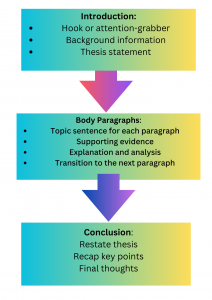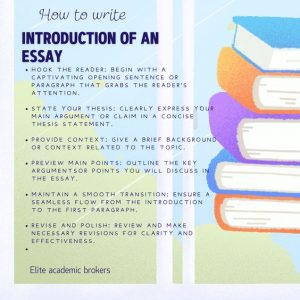How to Write an Essay Structure
Writing a well-structured essay is a fundamental skill that every student in college should have. Whether you’re writing a high school essay or a graduate-level research paper, the structure you choose is important in shaping your argument and ensuring clarity.
A proper essay structure provides a logical flow for ideas, making your writing easier to follow and more persuasive. It consists of three main parts: the introduction, body paragraphs, and conclusion. Each section serves a distinct purpose, and when effectively executed, they create a cohesive, engaging piece of writing.
This essay will explore the essential components of essay structure, highlighting key elements and offering guidance on how to organize your thoughts for maximum impact.
A well-structured essay ensures clarity, logical progression, and strong argumentation. It consists of three main parts,
Introduction – Provides context and presents the thesis statement.
- hook
- background information
- Thesis statement
Body – Develop the argument with structured paragraphs.
- Topic sentence
- Supporting evidence
- Explanation and analysis
- Transition to the next paragraph
Conclusion – Summarizes key points and reinforces the argument.
- Restate thesis
- Recap key points
- Final thought

Each of these sections has a specific purpose and must be written carefully to achieve coherence and effectiveness.
1. Introduction: Setting the Stage
The introduction is the first impression your essay makes. A strong introduction should,
Engage the reader – Start with a compelling hook.
Provide necessary background – Explain the context of the topic.
Define key terms – If necessary, clarify concepts.
State the thesis – Present the central argument.
Outline the essay structure – Give the reader a sense of direction.

Elements of a Strong Introduction
| Component |
Purpose |
Example (Essay on “The Impact of Social Media on Mental Health”) |
| Hook |
Capture the reader’s interest |
“With over 4.8 billion social media users worldwide, platforms like Instagram, TikTok, and Facebook have become deeply embedded in daily life.” |
| Background |
Provide context on the topic |
“While social media connects people across the globe, it also raises concerns about mental health, particularly among teenagers.” |
| Key Definitions |
Define important terms |
“Mental health refers to a person’s emotional, psychological, and social well-being.” |
| Thesis Statement |
Present the central argument |
“This essay will argue that excessive social media use negatively affects self-esteem, sleep patterns, and anxiety levels.” |
| Outline |
Preview the main points |
“The essay will first discuss the impact of social media on self-esteem, followed by its effects on sleep, and finally its link to anxiety.” |
Example of a Well-Structured Introduction
Essay Topic: The Impact of Social Media on Mental Health
“With over 4.8 billion social media users worldwide, platforms like Instagram, TikTok, and Facebook have become deeply embedded in daily life. While social media connects people across the globe, it also raises concerns about mental health. Studies show that excessive social media use can lead to anxiety, depression, and sleep disturbances. This essay will explore the psychological effects of social media, focusing on self-esteem, sleep deprivation, and anxiety. By analyzing recent research, it will argue that while social media offers benefits, its negative impact on mental well-being cannot be ignored.”
Why is this effective?
- Hook: Startling statistics about social media usage.
- Background: Brief mention of its role in society.
- Thesis: Clearly states the main argument.
- Essay Outline: Mention the three key focus areas.
2. Body Paragraphs: Building the Argument
The body of the essay contains multiple paragraphs, each focusing on a specific idea that supports the thesis. Each paragraph should be well-structured and logically connected.
The Structure of a Body Paragraph (TEEL Method)
Each paragraph should follow the TEEL format:
- Topic Sentence – Introduces the paragraph’s main idea.
- Explanation – Expands on the topic with details.
- Evidence – Supports the claim with facts, research, or examples.
- Link/Transition – Connects to the next paragraph.
Example of a Strong Body Paragraph
Point 1: Social Media Lowers Self-Esteem
(Topic Sentence) – Social media negatively impacts self-esteem by promoting unrealistic beauty standards.
(Explanation) – Many users compare themselves to influencers and celebrities, leading to dissatisfaction with their appearance.
(Evidence) – A study by the American Psychological Association (2022) found that 67% of teens felt worse about their looks after scrolling through Instagram for 30 minutes.
(Analysis) – This phenomenon, known as “social comparison,” fosters low self-worth, particularly among young users. Unlike real-life interactions, social media presents a curated version of reality, causing users to feel inadequate.
(Link) – Therefore, the illusion of perfection created by social media significantly shapes self-perception, which leads to broader mental health concerns.
Structuring Multiple Body Paragraphs
For a well-organized essay, body paragraphs should be logically ordered. Below is an example structure for a three-paragraph body section in an essay about social media’s impact on mental health.
Paragraph 1: Social Media Lowers Self-Esteem
- Discuss social comparison theory and body image concerns.
- Provide examples of influencers promoting unrealistic beauty standards.
- Use statistical evidence from recent studies.
Paragraph 2: Social Media Causes Sleep Deprivation
- Explain the effect of blue light on melatonin production.
- Discuss doomscrolling and its impact on sleep patterns.
- Use medical studies to show the link between social media and poor sleep quality.
Paragraph 3: Social Media Increases Anxiety
- Discuss constant notifications and digital overstimulation.
- Provide examples of social media addiction and FOMO (Fear of Missing Out).
- Reference psychological studies on increased anxiety levels.
 Tip: Use clear transitions to ensure logical flow between paragraphs.
Tip: Use clear transitions to ensure logical flow between paragraphs.
3. Conclusion: Wrapping It Up
A strong conclusion should:
Restate the thesis – Paraphrase your main argument.
Summarize key points – Briefly review the main arguments.
Provide a closing thought – End with a thought-provoking idea, recommendation, or call to action.
Example of a Well-Written Conclusion
“In conclusion, while social media serves as a powerful tool for communication and self-expression, its negative effects on mental health cannot be overlooked. The evidence highlights its role in lowering self-esteem, disrupting sleep patterns, and increasing anxiety levels. As digital engagement continues to rise, individuals must practice mindful social media use to protect their mental well-being. Ultimately, moderation and awareness are key to maintaining a healthy relationship with social media in the modern world.”
Why is this effective?
- Restate the thesis in a new way.
- Summarizes key points without repeating details.
- Offers a closing thought by emphasizing balance and awareness.
 Tip: Never introduce new arguments or evidence in the conclusion.
Tip: Never introduce new arguments or evidence in the conclusion.
4. Formatting and Style Considerations
Academic essays should follow specific writing conventions:
| Element |
Guidelines |
| Tone & Style |
Use formal language and avoid slang. |
| Citations |
Always cite sources in the required format (APA, MLA, Chicago, etc.). |
| Paragraph Length |
Each paragraph should focus on one clear idea (typically 4-7 sentences). |
| Transitions |
Use words like furthermore, in contrast, as a result, to ensure logical flow. |
| Proofreading |
Always edit for grammar, coherence, and clarity before submission. |
Conclusion
The structure of an essay is essential for successful academic writing. By clearly organizing your work into a well-defined introduction, body paragraphs, and conclusion, you ensure that your ideas are communicated effectively.
The introduction sets the stage, the body develops and supports the thesis, and the conclusion reinforces the argument. With a solid understanding of essay structure, you can approach any writing task with confidence, knowing that your work will be coherent, persuasive, and easy to follow.
Whether you’re writing a short response or an extensive research paper, a well-structured essay remains the key to effective communication.
Check on various structure
Analytical Essay Structure
Argumentative essay structure
Cause and Effect Essay Structure
Compare and contrast essay structure
narrative essay structure
Persuasive essay structure











 Tip: Use clear transitions to ensure logical flow between paragraphs.
Tip: Use clear transitions to ensure logical flow between paragraphs.